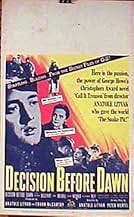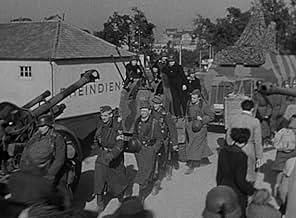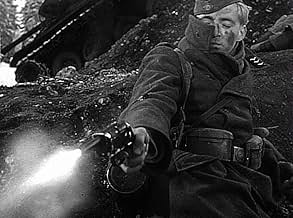CALIFICACIÓN DE IMDb
7.2/10
3.2 k
TU CALIFICACIÓN
As the US Army approaches Nazi Germany, they recruit German prisoners of war to spy behind German lines.As the US Army approaches Nazi Germany, they recruit German prisoners of war to spy behind German lines.As the US Army approaches Nazi Germany, they recruit German prisoners of war to spy behind German lines.
- Dirección
- Guionistas
- Elenco
- Nominado a 2 premios Óscar
- 1 premio ganado y 4 nominaciones en total
Hildegard Knef
- Hilde
- (as Hildegarde Neff)
Wilfried Seyferth
- Heinz Scholtz - SS Man
- (as Wilfried Seyfert)
Robert Freitag
- Sgt. Paul Richter
- (as Robert Freytag)
Harold Benedict
- Lt. Pete Gevers
- (as H.L. Benedict S/Sgt. USAF)
H.W. Briggs
- Self
- (as H.W. Briggs Sgt. USA)
D.G. Devine
- Lt. Rennick's Driver
- (as D.G. Devine Cpl. USAF)
L.E. Dixon
- Self
- (as L.E. Dixon Maj. USA)
B.L. Hendrickson
- Self
- (as B.L. Hendrickson T/Sgt. USA)
Opiniones destacadas
The movie puts you in WWII's closing days as you watch an idealistic young German Army medic become a traitor to his country by working as a spy in order to let the war end quickly and let peace return. The movie extras are former German soldiers, and you can tell by how they wear their "rag tag" uniforms and bark out commands in German. The scenes are superb. Bombed out areas of Germany were used, and one scene in a bombed out theater is especially great. You hear the falling glass and metal structures as the Gestopo search for the soldier. It is simply a very entertaining movie that lets one ponder: What would I have done if I were in his place?
As American forces approach Germany near the end of World War II, it becomes crucial for them to get an idea of the Germans' capacity to resist. In order to do that, they recruit spies from among German POWs, train them and send them into Germany to gather information. This is somewhat of an unusual film about a subject that, as far as I know, had never been dealt with before or since (the movie is based on fact; American military intelligence did indeed use German POWs as spies). The location filming helps the picture greatly, as the war had only been over for a few years and Germany still hadn't rebuilt yet. Performances are universally top notch, notably Oskar Werner as a young German soldier code-named Happy who volunteers to return as a spy, and especially Hans Christian Blech as Happy's tough, opportunistic, and not entirely trustworthy partner. There are some nail-biting moments, notably aboard a train when Happy and his partner come under scrutiny by a suspicious Gestapo agent. The film has a tough, gritty, dangerous look that is totally atypical of the usual 20th Century Fox gloss, and is all the better for it. Gary Merrill as the tough American officer in charge of the operation, and Richard Basehart as an American agent sent in to accompany the two German spies, also turn in first-rate performances, and director Anatole Litvak keeps the film full of twists and surprises, but it's Oskar Werner's show, and he is up to it. An excellent film and one to put on your must-see list.
Having served in the US Army-Europe in Germany it was easy to see that this work was an accurate depiction of the world as Germans saw it in those years. Going to the IMDb database confirmed that it was filmed in Wurzberg, a city I visited many times. One can not help but wonder what memories and nightmares came back to life for the German people in this movie, or the ones who viewed it, or even witnessed the movie being made. The film is so very realistic in script, acting, and setting that some must have almost thought WWII was alive again. For those that lived through WWII in that country it must have seemed as if those days were repeating themselves. Every detail of this movie is accurate as far as I could tell. It does not employ overused stereotypes, no action heroes, no earth shaking grand and glorious finale, it simply depicts a period of time in all its' tragedy and irony in a most realistic manner. This work deserves more praise and exposure than it has received. A must see for every WWII researcher and historian.
For anyone who is used to freedom, this movie shows better than any other what it is like to live in a total police state. The Thousand-Year Reich is shown with every wart and blemish, making this one of the greatest propaganda movies for freedom. But it is a harrowing experience, a true thriller. For the life of me, I cannot understand why this film is not better known and why it is hardly available in public libraries. Could this reflect the conservative, McCarthyite influence on movies? I think it is a must-see.
Surprisingly good war film unknown to me before I saw it on American Movie Classics. Cast is excellent. Characters are well-drawn. The film is the best portrayal I have yet seen on celluloid of Germany in its stages of final collapse as the end of WWII nears. Some very impressive interiors are beautifully shot - the cathedral that serves as intelligence hq, and the castle or chateau that is the German command hq. Engrossing story of conflicted loyalties, and good action and suspense as well. I can only add my agreement with the positive comments already entered.
¿Sabías que…?
- TriviaOne of the first films after World War II to portray the German people--outside of the Nazi regime--in a sympathetic light.
- ErroresKarl is mistakenly called a corporal. The Luftwaffe uniform that he wears both in the US POW cage and while back in Germany has the rank insignia of an "Obergefreiter", specifically three winged emblems on the collar patches, plain shoulder straps and two chevrons on his left sleeve. Also when the list is checked for his name at the bridge the rank is written down as 'Gfr' (gefreiter) The ranks of Gefreiter, Obergefreiter and Stabsgefreiter (all which were partially identified by chevrons on the sleeve) were not NCOs and had no command authority over other soldiers. They were simply grades of seniority and would be more equivalent to Private First Class (PFC) in the US military. The German rank that is the closest equivalent to Corporal is Unteroffizer. Also, Karl is wearing the medical badge on his right sleeve; Luftwaffe enlisted medical personnel wore the badge on the left sleeve, while Wehrmacht (army) wore it on the right.
- Citas
Lt. Dick Rennick: [Intro narration] Of all the questions left unanswered by the last war, and probably any war, one comes back constantly to my mind. Why does a spy risk his life... for what possible reason? If the spy wins, he's ignored. If he loses, he's shot.
- ConexionesReferenced in Esa chica: Decision Before Dawn (1968)
- Bandas sonorasAch, wie ist' möglich dann (Treue Liebe)
(uncredited)
Written by Friedrich Kücken (1827)
Selecciones populares
Inicia sesión para calificar y agrega a la lista de videos para obtener recomendaciones personalizadas
- How long is Decision Before Dawn?Con tecnología de Alexa
Detalles
- Fecha de lanzamiento
- Países de origen
- Idiomas
- También se conoce como
- Decision Before Dawn
- Locaciones de filmación
- Productoras
- Ver más créditos de la compañía en IMDbPro
- Tiempo de ejecución1 hora 59 minutos
- Color
- Relación de aspecto
- 1.37 : 1
Contribuir a esta página
Sugiere una edición o agrega el contenido que falta

Principales brechas de datos
By what name was Decisión al amanecer (1951) officially released in India in English?
Responda






























